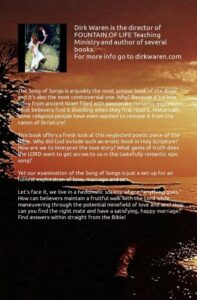FORMS OF ART IN THE BIBLE, Including Music, Visual and Performance Art
God’s imaginative creation of the Universe & Earth and all living things (chronicled in Genesis 1-2) can be described as art; after all, a lot of our art appreciation involves marveling at awesome displays of nature, amazing animals or attractive, charismatic people. This shows that art began with the LORD, the creator of the heavens & earth and all living creatures (Psalm 146:6), and we are to be “imitators of God” (Ephesians 5:1).
But what about the first reference of art relating to human beings and even as an industry? (By ‘industry’ I mean the production of a good or service for people in the community to utilize). Here’s the first mention in Scripture:
Adah gave birth to Jabal; he was the father of those who live in tents and raise livestock. 21 His brother’s name was Jubal; he was the father of all who play stringed instruments and pipes. 22 Zillah also had a son, Tubal-Cain, who forged all kinds of tools out of bronze and iron.
Genesis 4:20-22
As you can see, three major industries are noted:
- Livestock, which relates to human sustenance.
- Music, which relates to art as a craft and human appreciation or entertainment (in the positive sense).
- Tool manufacturing, which relates to technology and human convenience or advancement.
Thus art is noted in the same breath as two other industries vital to human existence.
Furthermore, tool manufacturing and the corresponding technology includes an element of art since various tools and the items created from tools are typically made with aesthetics in mind and are themselves art in a sense. For instance, chairs, tables, desks, shelves, utensils and weapons, like swords. (For anyone who doubts that a chair or table relates to technology, technology is defined as the application of scientific knowledge for practical purposes, so designing and building a wooden chair or table would be an application of technology). Consider vehicles in the modern era, which are a tool to travel from point A to point B: They can be created solely with utilitarian concerns in mind, but that’s usually not the case; manufacturers are also concerned with aesthetics, which explains the existence of car shows.
All three of these industries were birthed at the same time in human history. In other words, people are not to just eat and use tools for one purpose or another, they can also create and appreciate art, whether music or otherwise.
Various Forms of Art Noted in the Bible
Several art forms can be observed in Holy Scripture:
- Music, as noted in the Psalms and Solomon’s Song of Songs. These songs feature a wide range of expression from praise & worship and historical commentary to emotional venting and (gasp!) romantic expression.
- Poetry, such as the book of Job, Ecclesiastes and the poetry used throughout the prophetic books.
- Fictional stories, like Christ’s parables and Jotham’s fantastical tale (Judges 9:8-15).
- Visual arts, including graphical, sculptural, crafts, décor and architectural (1 Kings 6). This would include the aesthetic appeal of the Ark of the Covenant and the Tent Tabernacle (Exodus 25-26).
- The aesthetic element in tools, weapons, armor and so on would fall within the parameters of visual art.
- Performance art, as observed with Isaiah walking around partially nude and barefoot for three years (Isaiah 20), Jeremiah creating and wearing a yoke, which was destroyed by another prophet to symbolize the breaking of the yoke of king of Babylon (Jeremiah 27-28) and Ezekiel “sieging Jerusalem” and lying on his side for long periods of time, etc. (Ezekiel 4-5). Obviously art can be used as a tool to minister truth to others.
- Dance would be a form of performance art. Ecclesiastes 3:4 says there is “a time to weep and a time to laugh, a time to mourn and a time to dance” while the Psalms encourage us to praise the LORD with dancing and music (Psalm 149:3 & 150:4). David danced before the LORD with all his heart, which some naturally took in the wrong spirit (2 Samuel 6:14-23). Aren’t there always those types who take offense to an artist despite perfectly noble intentions?
All of these art forms separate human beings from animals. Beasts do not create or perform with aesthetics in mind, even if what they create for practical purposes can be deemed as artistic by people, like a spider’s web. As noted above, art is as intrinsic to the human experience as food and technology.
Lifeless Legalists Tend to Sneer at Art and Those Involved in the Arts
To be expected, those with a Pharisaical spirit — legalists — tend to look down on some forms & genres of art because it brings pleasure and heightens the appreciation of life whereas legalists are by nature life-stifling and growth-stultifying. But, as you can see from the Scriptures, art is inherent to God’s nature and, as such, many forms of it can be seen throughout the Bible. Moreover, we are created in God’s image and expected to imitate our Creator.
Speaking of which…
God’s “Art” Declares the Glory of the Creator
It was pointed out earlier that God’s physical creation — the Universe, Earth and all living things — is the LORD’s art and it is on display to humanity every day, testifying to the Creator’s existence and glory despite the creation’s fallen state (Romans 1:20 & Psalm 19:1-4). Have you ever heard a great song or seen it performed and felt an awe of the artist who composed/performed it? The same principle is at play when you gaze into the starry panorama or feast your eyes on a magnificent vista or marvel at a stunning person or a fascinating animal. All of these things declare the glory of the Creator and inspire awe.
The art you or I create can also inspire awe and “speak” of innumerable worthy things or issues, but the most important one is declaring God’s glory or simply truth (reality) in one way or another, covertly or overtly. By doing this we are imitating God as we are called to do.
But, in order for art to be effective…
Artists Must “Understand the Times”
The Bible points out that the men of Issachar “understood the times and knew what Israel should do” (1 Chronicles 12:32), which shows that they comprehended the historical context of the current culture and what to do or not do from a godly perspective. Just so, Christian artists in the modern era have to grasp what’s happening in their culture or subculture in order to effectively engage people with their art, whatever form that might be.
For instance, it’s unlikely that Christians are going to effectively reach lost or searching youths ingrained in Goth rock, hip-hop or extreme metal subcultures with traditional gospel music, like The Gaithers. Not that there’s anything wrong with traditional gospel — I love it (and I love The Gaithers) — but you have to know your audience and what’s trending to successfully reach people and communicate with your art. What’s “hip” in one decade is usually not “hip” in the next one.
Creating Art is Work
Artists are typically looked-down upon by more utilitarian types. They don’t view the creation or performance of art to be “real work” nor do they think the art industry — any form — is essential to life on Earth. But, as noted above, the very beginning of the book of Genesis shows that art was one of the three main industries in the beginning stages of humanity (Genesis 4:20-22).
Furthermore, God’s creation of the Universe & Earth and all living things is the most imaginative, awe-inspiring piece of art ever created. Notice what the Bible says about this masterwork:
Thus the heavens and the earth were completed in all their vast array.
2By the seventh day God had finished the work he had been doing; so on the seventh day he rested from all his work. 3Then God blessed the seventh day and made it holy, because on it he rested from all the work of creating that he had done.
Genesis 2:1-3
The Scriptures refer to the LORD’s creation of the greatest piece of art as “work,” which took six days to complete. We marvel at innumerable parts of this “piece” every day one way or another. For instance, we regularly gaze in awe at photographs, paintings, books or movies showcasing magnificent vistas, amazing animals or stunning people — or we appreciate them firsthand — either way, we’re blessed by God’s art on a daily basis.
The point is that creating great art is work. It was work even before creation was cursed due to sin (Genesis 3:14-20). Now it’s even more work because of the Genesis Curse; and Adam’s descendants have worked within the context of this negative legacy ever since, which includes you and me. But there’s good news…
Christ worked as a carpenter up until the age of 30; his former neighbors in Nazareth recognized him by his prior occupation (Mark 6:3 & Matthew 13:55). The Greek word for ‘carpenter’ is tektón (TEK-tohn), which refers to a craftsman, carpenter or artisan. Tektón is where we get the words tectonic and architect. In 1st Century Israel a tektón was a general craftsman who worked with wood, stone or metal in building projects, small or large. In other words, Christ did more than make tables & chairs.
Quality carpenters/builders/architects today make good money, as do people of any profession that takes skill and is in demand, including proficient artists (Proverbs 22:29). As noted earlier, there’s a creative element to carpentry and architecture. Imagine how skilled the Messiah was as a builder since he created the Universe, Earth & all living things (Colossians 1:16-17)!
Jesus then worked as a fulltime minister for three and a half years before he was crucified and he was the greatest minister that’s ever walked the Earth. Anyone who says effective ministry isn’t work doesn’t know what they’re talking about. Moreover, there’s a creative element to ministry, including the imagination necessary to come up with original teachings and parables, not to mention ministering via performance art as Jeremiah and Ezekiel did, noted earlier. In short, ministry includes an artistic aspect.
Whatever work you do, including artistic work, Colossians 3:23 instructs us to:
- Work as if working for the Lord, which is also reflected in Ephesians 6:7.
- Do it with all your heart, which is also reflected in Ecclesiastes 9:10. Look at the opening photo of this article and note how the band is performing wholeheartedly. The lesson? Give it your all; don’t just go through the motions or wing it.
In addition, Proverbs 12:24 says that “diligent hands will rule” and Proverbs 22:29 illustrates that those who perfect their craft will be successful within that context; in other words, your work will be in demand however large or small your niche audience.
Apply these principles in your work & artistic endeavors and you’ll be blessed despite the Genesis Curse while looking forward to the new heavens and new earth, the eternal home of righteousness where there will be “no more curse” (2 Peter 3:13 & Revelation 22:3).
This article is also available in book form as a chapter in…
- The print book is available here for only $7.26 (171 pages)
- The Kindle eBook is available here for just 99¢!
Both links allow you to LOOK INSIDE the book.
Related Topics:
Can a Certain Style of ART be Evil?
Q&A on Solomon’s Song of Songs
comments powered by Disqus





